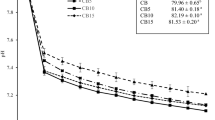Abstract
The effect of blending wheat flour with fluted pumpkin (Telfairia occidentalis Hook) seed flour at levels of 0 to 10% on selected chemical and nutritional properties of composite breads was investigated. Bread loaves were prepared using the straight-dough procedure. Protein quality was evaluated using weanling male albino rats fed composite bread diets which were formulated to supply 10% protein, with casein diet as a control. When wheat flour was replaced with 10% defatted fluted pumpkin seed flour, there was an increase of 80.8% in crude protein, 43.9% in calcium, 71.9% in potassium and 63.0% in phosphorus contents of composite breads. Diets formulated with 5% or 10% fluted pumpkin–substituted breads showed significantly (p < 0.05) higher values for weight gain, protein efficiency ratio, apparent and true digestibilities than diets formulated with 100% wheat flour bread, suggesting an improvement of the nutritional quality of fluted pumpkin–substituted composite breads.
Similar content being viewed by others
References
UNECA (1985) Technical compendium on composite flours, Ethiopia: United Nations Economic Commission for Africa.
Longe OG, Farinu GO, Fetuga BL (1983) Nutritional value of the fluted pumpkin (Telfairia occidentalis) J Agric Food Chem. 31: 989–992.
Achinewhu SC (1987) Protein quality evaluation of weaning food mixtures from indigenous fermented foods. Nig J Nutr Sci 8: 23–31.
Banigo EB, Akpapunam MA (1987) Physico-chemical and nutritional evaluation of protein- enriched fermented maize flour. Nig Food J 5: 30–36.
Barber LI, Ibiama EA, Achinewhu SC (1989) Microorganisms associated with fermented fluted pumpkin seeds (Telfairia occidentalis). Int J Food Sci Technol 24: 189–193.
Giami SY, Bekebain DA (1992) Proximate composition and functional properties of raw and processed full-fat fluted pumpkin (Telfairia occidentalis) seed flour. J Sci Food Agric 59: 321–325.
Giami SY, Isichei I (1999) Preparation and properties of flours and protein concentrates from raw, fermented and germinated fluted pumpkin (Telfairia occidentalis Hook) seeds. Plant Foods Hum Nutr 54: 67–77..8
Giami SY (2000) Effect of addition of fluted pumpkin (Telfairia occidentalis) seed flour on rheological properties of dough and baking quality of bread. In: Nkama I, Jideani VA, Ayo JA (eds), Proceedings of the 24th Annual Conference of the Nigerian Institute of Food Science and Technology, Bauchi, Nigeria November 20-24, pp 29–30.
Nmorka GO, Okezie BO (1983) Nutritional quality of winged bean composite breads. Cereal Chem 60: 198–202.
Kailasapatty K, Perera PAJ, Macneil JH (1985) Improved nutritional value in wheat bread by fortification with full-fat winged bean flour (Psophocarpus tetragonolobus L.D.C) J Food Sci. 50: 1693–1696.
Nochera C, Caldwell M (1992) Nutritional evaluation of breadfruit-containing composite flour products. J. Food Sci 57: 1420–1422, 1451.
Chauhan GS, Zillman RR, Eskin NAM (1992) Dough mixing and bread making properties of quinoa-wheat flour blends. Int J Food Sci Technol 27: 701–705.
AOAC (1984) Official methods of analysis, 14th edn. Washington, DC: Association of Official Analytical Chemists.
Achinewhu SC, Isichei MO (1990) The nutritional evaluation of fermented fluted pumpkin seeds (Telfairia occidentalis Hook). Discovery and Innovation 2: 62–65.
Pellet PL, Young VR (1980) Nutritional evaluation of protein foods. Food Nutri Bull, Suppl No 4, Japan: United Nations University.
Wahua TAT (1999) Applied statistics for scientific studies. Aba-Nigeria: African-Link Press.
Giami SY, Chibor BS, Edebiri KE, Achinewhu SC (1999) Changes in nitrogenous and other chemical constituents, protein fractions and in-vitro protein digestibility of germinating fluted pumpkin (Telfairia occidentalis Hook) seed. Plant Foods Hum Nutr 53: 333–342.
Khokhar S, Chauhan BM (1986) Effect of domestic processing and cooking on in-vitro protein digestibility of moth bean. J Food Sci 51: 1083–1084.
Igbedioh SO, Olugbemi KT, Akpapunam MA (1994) Effects of processing methods on phytic acid level and some constituents in bambara groundnut (Vigna subterranea) and pigeon pea (Cajanus cajan) Food Chem 50: 147–151.
Author information
Authors and Affiliations
Rights and permissions
About this article
Cite this article
Giami, S., Mepba, H., Kiin-Kabari, D. et al. Evaluation of the nutritional quality of breads prepared from wheat-fluted pumpkin (Telfairia occidentalis Hook) seed flour blends. Plant Foods Hum Nutr 58, 1–8 (2003). https://doi.org/10.1023/B:QUAL.0000041167.61992.4d
Issue Date:
DOI: https://doi.org/10.1023/B:QUAL.0000041167.61992.4d




